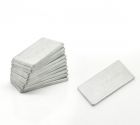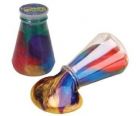Radiometer, Crooke's, extra large
Embellish your room with this quality science curiosity.
Consisting of a glass bulb with a partial vacuum and low friction spindle, this decorative radiometer is based on technology from the 1800s. When electromagnetic radiation such as light or even heat from a person's hand enters the bulb the vanes turn. The black turns away from the source of the radiation, and the white towards it.
This hand made radiometer makes an attractive room ornament and is an interesting lesson in energy transformation.
Age: 12+ under adult supervision, made of fragile glass.
What You Get
Decorative Radiometer. Includes one hand-made glass radiometer, 22cm high.
How Does it Work?
Also known as the light mill, or solar engine, the radiometer demonstrates how heat can be transformed into movement energy. Its invention in 1873 is credited to Sir William Crookes, an English physicist.
When the black vanes inside the radiometer are exposed to a warm energy source like the sun or a table lamp, they spin. The more powerful the heat source, the faster the vanes spin.
The black side of the vane absorbs heat faster than the polished silver/white side, raising the temperature and pressure of the air molecules behind the black vanes and causing the spinning motion.
Teach
- Heat Engine (the radiometer effectively becomes a heat engine when heat energy, such as light, is directed at it)
- Sustainable and solar energy
- Thermodynamics
- Black-body absorption the black vanes inside the radiometer heat up quickly because they absorb all radiation falling on them. This contrasts to the other white/silver side of the vanes
- Light energy and electromagnetic radiation
WARNING: CHOKING HAZARD Small Parts. Not for children under 3 years.
| Length (cm) | 14 |
|---|---|
| Width (cm) | 14 |
| Height (cm) | 30 |
| Age Group | 11-12 Years, 12+ Years |











